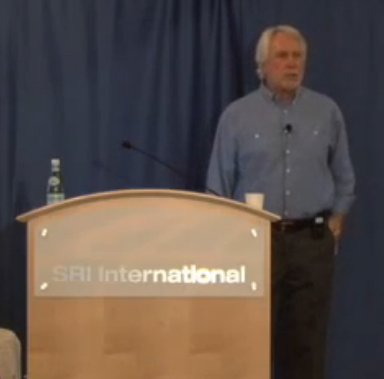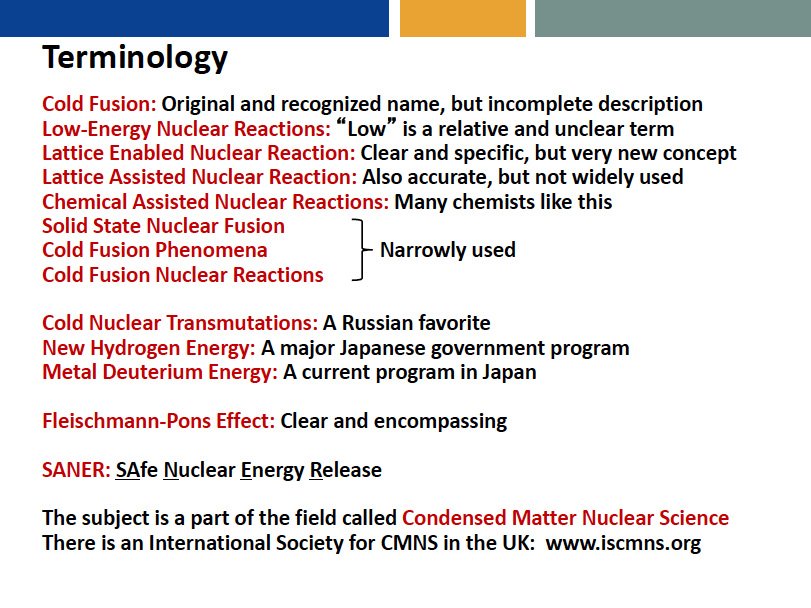In the beginning was the Word, and the Word was with God, and the Word was God. –John 1:1 Holy Bible
The name cold fusion describes the biggest technological advance in energy since humans tamed fire. It also continues to generate intense emotional responses, both positive and negative.
Such is the Power of Word.

In this presentation slide below, he notes the vocabulary characterizing various aspects of condensed matter nuclear science. Dr. McKubre described a few of the terms during the introduction of the lecture.
“All of these terms in red are used to describe what was announced on March 1989 as cold fusion. The term cold fusion actually came from previous work in hot fusion – muon catalyzed hot fusion.
The term stuck, it’s unfortunate, it irritated the physicists. I think the physicists would have been irritated anyway, but this didn’t help.
In attempts to soften the blow we’ve called it low energy nuclear reactions or lattice assisted nuclear reactions – LENR/LANR. Those terms are not very good. Low is subjective and pejorative – you know we don’t really want to produce low energy.
And nuclear is always a bad word. We took the nuclear out of nuclear magnetic resonance and called it magnetic resonance imaging because sociologically, nuclear is not a good term.
Chemically assisted nuclear reactions. A whole slew of things.
The Japanese rather coyly called it new hydrogen energy which really conceals a wealth under that phrase.
If we’re talking about the Fleischmann-Pons Effect, the effect that Martin Fleischmann and Stanley Pons announced to the world on March 23 which was the electrolytic production of excess energy from a cell containing heavy water D20 and a palladium cathode, then the Fleischmann-Pons Effect is an accurate descriptor.
But the field has expanded vastly beyond that, and we now have an overall terminology condensed matter nuclear science attempting to distinguish what we do from what physicists do with high-energy particles or high-temperature plasmas.” –Michael McKubre
Each name expresses a particular aspect of a highly elusive process that has defied explanation for more than two decades.
As long as there is no definitive theory and scientists are still not sure how this special excess heat effect is initiated, or what the Nuclear Active Environment really is, there will be no definitive name.

One reason the moniker ‘cold fusion’ has “stuck” is that, as the Palladium-Deuterium Pd-D systems have shown, deuterium in can give rise to measurements of Helium out.
In this slide from Dr. McKubre’s presentation, we see excess heat is positively correlated with the production of Helium. The slope of the line represents the rate of change of energy per helium measured and is close to 31 MeV, +/- the error.
Assuming two deuterium nuclei pair up to form a helium nuclei, the measure of the heat generated, or Q-value, would be 24 MeV. Dr. McKubre believes that the observed higher bias may be due to experimental design elements, and that a value closer to the expected 24 MeV Q-value is possible.

In Pd-D systems, two deuterium nuclei are somehow ending up to form a Helium nuclei, which is the essence of fusion, but not fusion as we know it now.
That can’t be all that’s going on either, for the excess heat effect is also generated from Nickel-Hydrogen Ni-H systems, which do not use a fuel of deuterium, but the simplest form of hydrogen, protium.
And because elements not originally present in a cell can be created during the process, there is also a transmutation effect, which could be from either fusion or fission inside the atomic matrix, or, some other new nuclear process.
For these outcomes to occur in different systems, creating multiple different effects, implies nuclear reactions occurring beyond conventionally known theories from 20th century physics.
Nevertheless, the name cold fusion reflects this idea of fusion occurring in “cold” circumstances, i.e. not hot plasmas.
“The future of the future is the present.”
Marshall McLuhan
In ancient times, before science, words were magic. Uttering a name gave power and dominion over that thing. Saying a word could bring whole universes into existence.
It will be remembered that Thoth is called the “scribe of the gods,” the “lord of writing,” the “master of papyrus,” the maker of the palette and the ink jar,” the “lord of divine words,” i.e., the holy writings or scriptures, and as he was the lord of books and master of the power of speech, he was considered to be the possessor of all knowledge both human and divine.

At the creation of the world it was he who reduced to words the will of the unseen and unknown creative Power, and who uttered them in such ways that the universe came into being, and it was he who proved himself by the exercise of his knowledge to be the protector and friend of Osiris, and of Isis, and of their son Horus. From the evidence of the texts we know that it was not by physical might that Thoth helped these three gods, but by giving them words of power and instructing them how to use them.
–E. Wallis Budge Egyptian Magic 1901
What we choose to call this transformational new energy technology will continue to evolve, until the secret formula is unlocked. In an instant, the simple, clear, perfect vision of our clean energy future will be summoned by a new and powerful Name. Scientists in every basement lab and every DOE office will be able to relax for a bit, and then get down to the hard work of implementing a revolution across the globe.
But the kids won’t care. They make up their own names. Change nouns to verbs, verbs to nouns, mess up the plural, create their own magic.
For this year, we’ll stick with Cold Fusion Now, not just cause we mean it, because it fits – and the kids dig it too!
Related Links
SRI International: “What happened to cold fusion?” video lecture with Michael McKubre at Cafe Scientifique by Ruby Carat November 21, 2011
Rumpelstiltskin Brothers Grimm from Short Stories


Informative article. I am primarily a philosopher, so words do count to me, but I find this discussion remarkably similar to politically correct speech. Watching liberals word craft so as to be the most politically correct is obnoxious (and the emotional reaction they have to people who use “politically incorrect” speech is even more obnoxious).
In my opinion, LENR (Low Energy Nuclear Reaction) is the most accurate. Cold fusion on the other hand, while much more meaningful and simple to the layman, is misleading. Never the less, as a practical matter, the layman wants the most simple noun (name) to describe it, regardless of wheither it is a fully descriptive (or accurate) verb.
“Call me any name you want, but just remember to call me for dinner.”
Ruby, what is interesting is the science will waste years debating what Cold Fusion should be called instead of just doing the bloody research.
That seems to be the limit of intellectual heights that many of them can achieve.
Cold Fusion is like Black Hole catchy and easy. it;s academic accuracy is totally irrelevant.
Just a crazy thought:
Perhaps the following consecutive reactions could take place in palladium saturated with deuterium.
Pd (N) + D > Ag*(N+2) (step1)
D + Ag*(N+2) > He(4) + Pd(N) (step 2)
_____________________________
Overall: D+D > He(4) + 24 MeV heat (no 24 MeV gamma ray)
P.S. Not very likely but it might be a way to explain the helium and 24 MeV of heat without 24 MeV gamma rays.
P.S. I’ll try to keep my obsessive thoughts to a minimum but the energy gains in step one would be:
Pd(102) + D > Ag(104) 10.3 MeV
Pd(104) + D > Ag(106) 10.7 MeV
Pd(105) + D > Ag(107) 13.1 MeV
Pd(106) + D > Ag(108) 10.8 MeV
Pd(108) + D > Ag(110) 11.1 MeV
Pd(110) + D > Ag(112) 11.4 MeV
Perhaps some isotopes would work better than others. So, it might be better to try pure isotopes instead of natural palladium in D-Pd systems.
Yo A, We love your obsessive thoughts!
It seems that “one-step” is too much to ask for. And either there are multiple reactions (cause excess heat works in other systems like Ni-H), or, it’s a series of reactions that will apply to multiple systems, or, ….both?
Edmund Storms seems to think that although there may be some transmutations taking place in D-Pd systems the majority of palladium is not being consumed. This two step process would use Pd in the reaction but not consume it (Think of the analogy of a catalyst in a chemical reaction that partakes in the reaction but is not consumed.).
As one who has had many nicknames I find myself returning to that first given, Greg. Cold Fusion will be the popular handle for a long time I think. It certainly is at lower temperatures than nuclear scientists expected. Consider this… In Cold Fusion (depending on the type) we see low energy nuclear reactions, lattice assisted nuclear reactions, chemically assisted nuclear reactions, and a new type of hydrogen energy which is not combustion. The study of all of these phenomenon in the many different reaction environments has led to a new field of science called Condensed Matter Nuclear Science. Popularly called Cold Fusion. It’s time for MIT and the DOE to admit it and stop obfuscating and misleading us.
Not so far in the distant future, the next generation in fact, will look back on our generation and know that the term energy shortage was a term for unenlightened minds. Gone is the Fire Era and welcome to the Fusion Era. Rumpelstiltskin awakes once again… to a new and hardly recognizable world. Still asleep or dreaming… I don’t think so. Watta’ ya’ groovin’ in… Clean… Cold Fusion. The Fusion Era.
“Cold Fusion” works for me until they figure it out. In the meantime, don’t let MIT and the DOE escape without a good schelacking for signaling thumbs down on potentially the best energy source mankind will ever encounter. Had they been honest scientists we’d be much farther along by now, I’m sure of it.
Very informative site. Seems like in our new language of initials, by any name LENR is still in the hands of the LEARNERs. All or Nothing? Indubitably, our bright young minds will produce an output closer to All and I pray the rest of us have the diligence, ability and motivation to suppress the voracity of those who would be economically threatened from devouring it as has happened, largely unreported, with electric cars. Unfortunately our media must focus on the needs of its advertisers, and more unfortunately our elected representatives primarily and almost exclusively focus on their interests in re-election.
Very well put in “My Fair Lady”, ‘ I get words all day through, first from them, now from you, is that all you blighters can do?’ Words? I feel Evil and Good is part of human nature. We take “D” from Devil to get evil, and add nothing, zero, zilch, “O” to God to get good, and irrespective of our beliefs, it all rests on these two letters, What we “DO” about what we think, know, cause, or allow. As Bob Schuller says, “If it’s going to be, it’s up to me.”
Ian Dhu
Hi Gentleman,
please if I’m not OT, what do You think about H + D fusion?
It seems to me an interisting hypothesis:
Hydrogen mass 1.007825 u.m.a.
Deuterium mass 2.014101 u.m.a.
Helium-3 mass 3.016029 u.m.a.
Mass defect rough 0.005897 u.m.a.
Electron mass 0.00054 u.m.a.
Mass defect (clear of two electron ) 0.004817 u.m.a.
1 u.m.a. is about 931.5 MeV
therefore:
H + D → He-3 + Energy (4.48 MeV)
a good energy value (moderate). Helium-3 is stable, no neutrons release.